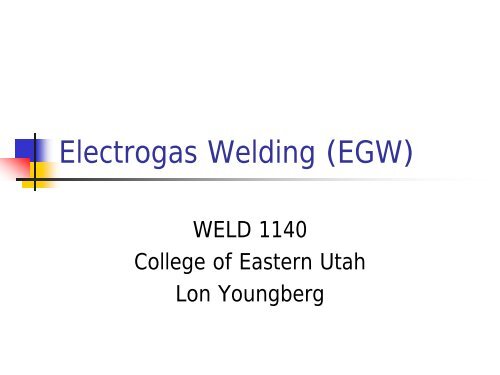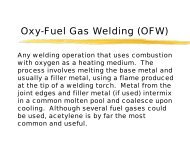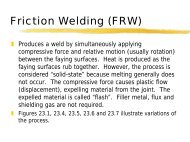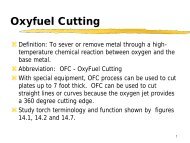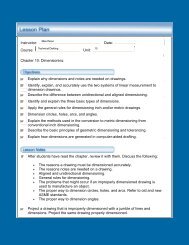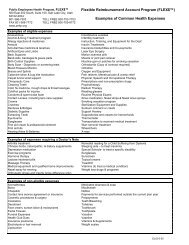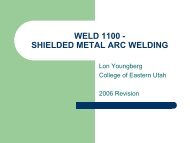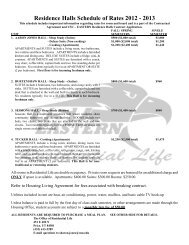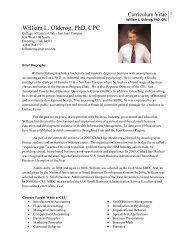Electrogas Welding (EGW) - College of Eastern Utah
Electrogas Welding (EGW) - College of Eastern Utah
Electrogas Welding (EGW) - College of Eastern Utah
Create successful ePaper yourself
Turn your PDF publications into a flip-book with our unique Google optimized e-Paper software.
<strong>Electrogas</strong> <strong>Welding</strong> (<strong>EGW</strong>)<br />
WELD 1140<br />
<strong>College</strong> <strong>of</strong> <strong>Eastern</strong> <strong>Utah</strong><br />
Lon Youngberg
<strong>EGW</strong> Description<br />
<strong>Electrogas</strong> welding is an arc welding<br />
process that is performed on verticallyoriented<br />
plates/structures. The process<br />
produces an arc between a continuously<br />
fed wire electrode and the weld pool.<br />
The weld pool is contained by some<br />
form <strong>of</strong> backing. External shielding gas<br />
and pressure may or may not be used.
<strong>EGW</strong> Interesting Facts<br />
Electroslag welding was invented first.<br />
<strong>EGW</strong> uses either sold wire, or flux-cored wire.<br />
Shielding gas (CO2 or Ar/CO2) is always used<br />
with solid wire and can be used with fluxcored<br />
wire.<br />
<strong>EGW</strong> is a machine welding process.<br />
Although the weld progresses in a vertical<br />
direction, the weld is deposited in the flat<br />
position.
Interesting Facts (cont.)<br />
Water-cooled copper retaining shoes<br />
are typically used on either side <strong>of</strong> the<br />
joint to hold the molten pool in place.<br />
<strong>EGW</strong> is commonly used for material<br />
thicknesses between ½” and 3”.<br />
Electrode diameters are typically from<br />
1/16” to 1/8”
<strong>EGW</strong><br />
A consumable guide is <strong>of</strong>ten used with<br />
short welds (about 4 ft max).<br />
When a consumable guide is used,<br />
none <strong>of</strong> the equipment (retaining shoes,<br />
wire feed mechanism) moves vertically.<br />
DCEN (reverse polarity) is normally<br />
used. Like SAW, a CV power supply is<br />
normally used, but CC may also be used
<strong>EGW</strong><br />
<strong>EGW</strong> power supplies are usually capable <strong>of</strong><br />
750 amps at 100% duty cycle.<br />
Retaining shoes (dams) are typically watercooled<br />
copper. However, steel backing strips,<br />
ceramic backups and combinations are<br />
sometimes used.<br />
<strong>EGW</strong> flux-core electrodes are not the same as<br />
FCAW (less slagging). Solid wires are<br />
typically the same as GMAW (except bigger).
<strong>EGW</strong><br />
Joint designs: see fig. 7.6 and 7.7<br />
Know the following features:<br />
Strongbacks<br />
Starting sump<br />
Run<strong>of</strong>f tabs
Metallurgical Concerns<br />
Since <strong>EGW</strong> is a high heat-input process<br />
where a large molten puddle is used,<br />
the cooling rate is very slow. This<br />
condition results in large (course),<br />
columnar grains in the weld zone and a<br />
wide heat affected zone (HAZ). Course<br />
grained microstructures typically lack<br />
toughness (resistance to fracture).
Angular Distortion & Stress<br />
Angular distortion (the “gull wing” shape <strong>of</strong> a<br />
SMAW certification plate) is minimal for <strong>EGW</strong><br />
when a symmetrical joint is used.<br />
Solidification begins at the outside edges.<br />
The result is that the outer surfaces <strong>of</strong> the<br />
completed weld are in compression and the<br />
center is in tension.
<strong>EGW</strong> variables<br />
Voltage: typically 30 to 35 volts<br />
Amperage: 300 to 1000 amps<br />
depending on the wire size.<br />
Electrode Extension:<br />
Gas shielded - usually about 1.5”<br />
Self shielded (flux core) – 2” to 3”<br />
Oscillation can be used
Discontinuities<br />
Porosity<br />
Ceterline Cracking<br />
Incomplete fusion at the sides<br />
Overlap<br />
Underfill<br />
Melt Through<br />
Hot Cracking


